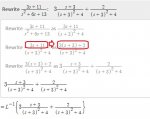\(\displaystyle \mbox{Excercise:}\)
\(\displaystyle \mbox{Rewrite }\, \dfrac{3s\, +\, 11}{s^2\, +\, 6s\, +\, 13}:\, 3\, \dfrac{s\, +\, 3}{(s\, +\, 3)^2\, +\, 4}\, +\, \dfrac{2}{(s\, +\, 3)^2\, +\, 4}\)
\(\displaystyle \mbox{Solution:}\)
\(\displaystyle \mbox{Rewrite }\, \dfrac{3s\, +\, 11}{s^2\, +\,6s\, +\,13}\, \mbox{ as }\, \dfrac{3s\, +\, 11}{(s\, +\, 3)^2\, +\, 4}\)
\(\displaystyle \mbox{Rewrite }\, \color{red}{ \dfrac{3s\, +\, 11}{(s\, +\, 3)^2\, +\, 4}\, \mbox{ as }\, \dfrac{3\, (s\, +\, 3)\, +\, 2}{(s\, +\, 3)^2\, +\, 4} }\)
\(\displaystyle \mbox{Rewrite }\, \dfrac{3\, (s\, +\, 3)\, +\, 2}{(s\, +\, 3)^2\, +\, 4}\, \mbox{ as }\, 3\, \dfrac{s\, +\, 3}{(s\, +\, 3)^2\, +\, 4}\, +\, \dfrac{2}{(s\, +\, 3)^2\, +\, 4}\)
3(s+3)2+4s+3+(s+3)2+42
. . . . .=L−1{3(s+3)2+4s+3+(s+3)2+42}
Hi, I am new to this forum so was just wondering if anyone can help on this issue. I am trying to understand how the numerator (in the red portion above) changes from 3s+11 to 3(s+3)+2 in the worked example given in the picture attached. Any help greatly appreciated
\(\displaystyle \mbox{Rewrite }\, \dfrac{3s\, +\, 11}{s^2\, +\, 6s\, +\, 13}:\, 3\, \dfrac{s\, +\, 3}{(s\, +\, 3)^2\, +\, 4}\, +\, \dfrac{2}{(s\, +\, 3)^2\, +\, 4}\)
\(\displaystyle \mbox{Solution:}\)
\(\displaystyle \mbox{Rewrite }\, \dfrac{3s\, +\, 11}{s^2\, +\,6s\, +\,13}\, \mbox{ as }\, \dfrac{3s\, +\, 11}{(s\, +\, 3)^2\, +\, 4}\)
\(\displaystyle \mbox{Rewrite }\, \color{red}{ \dfrac{3s\, +\, 11}{(s\, +\, 3)^2\, +\, 4}\, \mbox{ as }\, \dfrac{3\, (s\, +\, 3)\, +\, 2}{(s\, +\, 3)^2\, +\, 4} }\)
\(\displaystyle \mbox{Rewrite }\, \dfrac{3\, (s\, +\, 3)\, +\, 2}{(s\, +\, 3)^2\, +\, 4}\, \mbox{ as }\, 3\, \dfrac{s\, +\, 3}{(s\, +\, 3)^2\, +\, 4}\, +\, \dfrac{2}{(s\, +\, 3)^2\, +\, 4}\)
3(s+3)2+4s+3+(s+3)2+42
. . . . .=L−1{3(s+3)2+4s+3+(s+3)2+42}
Hi, I am new to this forum so was just wondering if anyone can help on this issue. I am trying to understand how the numerator (in the red portion above) changes from 3s+11 to 3(s+3)+2 in the worked example given in the picture attached. Any help greatly appreciated
Attachments
Last edited by a moderator:

